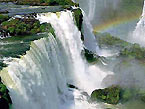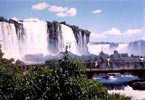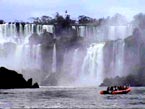

















One of the Seven Wonders of the World

Iguassu Falls is a place that must be seen and heard in person. The view at the falls precipice is hypnotizing. You will be treated to a multi-sensory experience: roaring falls, huge rainbow arcs, drenching mist, and, in the distance, parrots and hawks cruising over a deep green jungle.
The falls are unequally divided between Brazil and Argentina. To see them properly, you must visit both sides. In Brazil you get the grand overview and in Argentina you get a closer look. The 275 falls are over 3 kilometers (2 miles) wide and 80 meters (260 feet) high, which makes them wider than Victoria, higher than Niagara, and more beautiful than either.
Attractions
• The Falls
 The Iguassu Waterfalls are situated inside the Iguassu National Park. They were formed 150 million years ago and consist of 275 single falls, which merge into one large waterfront during times of flooding. There are 19 large falls, of which only 3 are to be found on the Brazilian side (Floriano, Deodoro and Benjamin Constant).
The Iguassu Waterfalls are situated inside the Iguassu National Park. They were formed 150 million years ago and consist of 275 single falls, which merge into one large waterfront during times of flooding. There are 19 large falls, of which only 3 are to be found on the Brazilian side (Floriano, Deodoro and Benjamin Constant).
The word "Iguassu" means "Great Water" in the language of the Tupy Guarani Indians. The river originates in the Serra do Mar and runs for 1320 km through the state of Paraná before it flows into the river Paraná at Foz do Iguassu.
• Brazilian and Argentina side tour

Some say, the best view of the falls can be enjoyed from the Brazilian side. In fact, due to the geography of the falls - most of them are situated on the Argentinean side and facing the Brazilian side - all of the falls can be seen in one grand view from the Brazilian side. Nevertheless, a visit to Argentinean side is also worth the 45m ride.
Before reaching the falls the river flows round a wide bend and down some rapids and then falls laterally to the bottom of a huge erosion fissure, forming the "Garganta do Diabo".
• Iguassu National Park
 The Iguassu National Park was created on January 1939. The Park is one of the largest reserves of "mata atlantica" in Brazil and represents one of the most recent environmental protection areas in the state of Paraná. The Park contains an area of 185 000 hectares of subtropical rain forest.
The Iguassu National Park was created on January 1939. The Park is one of the largest reserves of "mata atlantica" in Brazil and represents one of the most recent environmental protection areas in the state of Paraná. The Park contains an area of 185 000 hectares of subtropical rain forest.
During the General Assembly of UNESCO in Paris on 1986 the Iguassu National Park was declared a HUMAN HERITAGE SITE
• Bird Park
 The Foz Tropicana Bird Park is an independent private enterprise; its objectives are reproduction of endangered species, environmental education and eco tourism. It covers an area of 16 hectares of subtropical forest near the National Park and stretches from the road to the river Iguassu. The visitor follows a 1000 m long and winding path through the forest, in which the aviaries have been located. He enters huge aviaries where he comes into close contact with the birds. He has the opportunity to take photos and observe the Brazilian birds at close range, such as: Macaws, toucans, parrots, and many more tropical species.
The Foz Tropicana Bird Park is an independent private enterprise; its objectives are reproduction of endangered species, environmental education and eco tourism. It covers an area of 16 hectares of subtropical forest near the National Park and stretches from the road to the river Iguassu. The visitor follows a 1000 m long and winding path through the forest, in which the aviaries have been located. He enters huge aviaries where he comes into close contact with the birds. He has the opportunity to take photos and observe the Brazilian birds at close range, such as: Macaws, toucans, parrots, and many more tropical species.
• Macuco Safari
 The Macuco Safari excursion induces a fantastic feeling of nature and adventure in the visitor.
The Macuco Safari excursion induces a fantastic feeling of nature and adventure in the visitor.
The tour starts by jeep riding for 3 km in the
Atlantic rainforest. Multilingual guides comment on fauna and flora. After the ride the visitor go to the Macuco fall, which falls between 1000 years old rocks 20m deep into the valley.
The last and most exciting part of the adventure takes the visitor up the Iguassu River towards the Garganta do Diabo Devil's troat in inflatable boats. The visitor is rewarded with a unique view of the falls.
• Helicopter Ride
 The exploration of the falls from above is an exciting adventure. The bird's perspective makes it possible to survey the total number of falls and the national park at the same time.
The exploration of the falls from above is an exciting adventure. The bird's perspective makes it possible to survey the total number of falls and the national park at the same time.
Helicopter taxi near the visitor's centre of the national park offers these panoramic flights. The flight over the falls takes 8 to 10 minutes.
• Zoo
The municipal zoological garden was inaugurated 10th June 1996. It is a good example of a neglected area transformed into a park offering relaxation, environmental education and tourism.
The park covers an area of 40.000m² and contains 20 enclosures with different animal species such as: quatis, monkeys, jaguars, toucans, macaws, amazon parrots, rheas, cranes, jays, swans and others
There are 1000 native trees in the park and three lakes, which receive their water from a spring.
• Itaipu Hydrelectric Power Plant
 The Itaipu power station was formed by collaboration between Brazil and Paraguay. The objective was, for both countries to use the hydroelectric potential of the river Paraná. The dam covers 15 municipal areas in the East of Paraná and one in Mato Grosso do Sul. Itaipu received its name from a small island in the middle of the river, where the actual power station was built. The Indians called the island "Itaipu", which means "the singing stone" because of the singing noise that the flowing water causes when it hits the rock. Because of its dimensions the Itaipu power station is regarded as the " work of the century". According to a worldwide survey by the association of American civil engineers it is recognized as one of the seven wonders of the modern world. More material was used and more workers employed than for the construction of the Euro tunnel.
The Itaipu power station was formed by collaboration between Brazil and Paraguay. The objective was, for both countries to use the hydroelectric potential of the river Paraná. The dam covers 15 municipal areas in the East of Paraná and one in Mato Grosso do Sul. Itaipu received its name from a small island in the middle of the river, where the actual power station was built. The Indians called the island "Itaipu", which means "the singing stone" because of the singing noise that the flowing water causes when it hits the rock. Because of its dimensions the Itaipu power station is regarded as the " work of the century". According to a worldwide survey by the association of American civil engineers it is recognized as one of the seven wonders of the modern world. More material was used and more workers employed than for the construction of the Euro tunnel.
• Puerto Iguassu (Argentina)
The first settlers of Puerto Iguazu arrived in 1901 on boats, which sailed on the river Paraná from Buenos Aires to Guaíra. On one of these boats arrived Victória Aguirre. Today, her name is well known; even the main road of the town has been named after her.
Puerto Iguazu is 10 km away from the town centre of Foz do Iguassu.
It has 28 000 inhabitants and it is an important tourist centre. Its airport is the fourth largest in the country and is in operation 24 hours per day.
Attractions: Parque National Iguazu, Cataratas Iguazu, Ilha de San Martin, excursion along the river, Sendero Macuco, Circuito Yacaratiá, moonshine walk, Casino Iguazú, photographic safari, triple border, and shopping.
Museums: Museo de Ciências Naturales (Parque Nacional Iguazu), Museo de la Selva and Museo Mborore. Further attractions can be visited in the province of Missiones:
The Jesuit ruins, the Wanda mines and the Uruguai hydroelectric dam.

Iguassu Falls is a place that must be seen and heard in person. The view at the falls precipice is hypnotizing. You will be treated to a multi-sensory experience: roaring falls, huge rainbow arcs, drenching mist, and, in the distance, parrots and hawks cruising over a deep green jungle.
The falls are unequally divided between Brazil and Argentina. To see them properly, you must visit both sides. In Brazil you get the grand overview and in Argentina you get a closer look. The 275 falls are over 3 kilometers (2 miles) wide and 80 meters (260 feet) high, which makes them wider than Victoria, higher than Niagara, and more beautiful than either.
Attractions
• The Falls
 The Iguassu Waterfalls are situated inside the Iguassu National Park. They were formed 150 million years ago and consist of 275 single falls, which merge into one large waterfront during times of flooding. There are 19 large falls, of which only 3 are to be found on the Brazilian side (Floriano, Deodoro and Benjamin Constant).
The Iguassu Waterfalls are situated inside the Iguassu National Park. They were formed 150 million years ago and consist of 275 single falls, which merge into one large waterfront during times of flooding. There are 19 large falls, of which only 3 are to be found on the Brazilian side (Floriano, Deodoro and Benjamin Constant).The word "Iguassu" means "Great Water" in the language of the Tupy Guarani Indians. The river originates in the Serra do Mar and runs for 1320 km through the state of Paraná before it flows into the river Paraná at Foz do Iguassu.
• Brazilian and Argentina side tour

Some say, the best view of the falls can be enjoyed from the Brazilian side. In fact, due to the geography of the falls - most of them are situated on the Argentinean side and facing the Brazilian side - all of the falls can be seen in one grand view from the Brazilian side. Nevertheless, a visit to Argentinean side is also worth the 45m ride.
Before reaching the falls the river flows round a wide bend and down some rapids and then falls laterally to the bottom of a huge erosion fissure, forming the "Garganta do Diabo".
• Iguassu National Park
 The Iguassu National Park was created on January 1939. The Park is one of the largest reserves of "mata atlantica" in Brazil and represents one of the most recent environmental protection areas in the state of Paraná. The Park contains an area of 185 000 hectares of subtropical rain forest.
The Iguassu National Park was created on January 1939. The Park is one of the largest reserves of "mata atlantica" in Brazil and represents one of the most recent environmental protection areas in the state of Paraná. The Park contains an area of 185 000 hectares of subtropical rain forest.During the General Assembly of UNESCO in Paris on 1986 the Iguassu National Park was declared a HUMAN HERITAGE SITE
• Bird Park
 The Foz Tropicana Bird Park is an independent private enterprise; its objectives are reproduction of endangered species, environmental education and eco tourism. It covers an area of 16 hectares of subtropical forest near the National Park and stretches from the road to the river Iguassu. The visitor follows a 1000 m long and winding path through the forest, in which the aviaries have been located. He enters huge aviaries where he comes into close contact with the birds. He has the opportunity to take photos and observe the Brazilian birds at close range, such as: Macaws, toucans, parrots, and many more tropical species.
The Foz Tropicana Bird Park is an independent private enterprise; its objectives are reproduction of endangered species, environmental education and eco tourism. It covers an area of 16 hectares of subtropical forest near the National Park and stretches from the road to the river Iguassu. The visitor follows a 1000 m long and winding path through the forest, in which the aviaries have been located. He enters huge aviaries where he comes into close contact with the birds. He has the opportunity to take photos and observe the Brazilian birds at close range, such as: Macaws, toucans, parrots, and many more tropical species.• Macuco Safari
 The Macuco Safari excursion induces a fantastic feeling of nature and adventure in the visitor.
The Macuco Safari excursion induces a fantastic feeling of nature and adventure in the visitor.The tour starts by jeep riding for 3 km in the
Atlantic rainforest. Multilingual guides comment on fauna and flora. After the ride the visitor go to the Macuco fall, which falls between 1000 years old rocks 20m deep into the valley.
The last and most exciting part of the adventure takes the visitor up the Iguassu River towards the Garganta do Diabo Devil's troat in inflatable boats. The visitor is rewarded with a unique view of the falls.
• Helicopter Ride
 The exploration of the falls from above is an exciting adventure. The bird's perspective makes it possible to survey the total number of falls and the national park at the same time.
The exploration of the falls from above is an exciting adventure. The bird's perspective makes it possible to survey the total number of falls and the national park at the same time.Helicopter taxi near the visitor's centre of the national park offers these panoramic flights. The flight over the falls takes 8 to 10 minutes.
• Zoo

The municipal zoological garden was inaugurated 10th June 1996. It is a good example of a neglected area transformed into a park offering relaxation, environmental education and tourism.
The park covers an area of 40.000m² and contains 20 enclosures with different animal species such as: quatis, monkeys, jaguars, toucans, macaws, amazon parrots, rheas, cranes, jays, swans and others
There are 1000 native trees in the park and three lakes, which receive their water from a spring.
• Itaipu Hydrelectric Power Plant
 The Itaipu power station was formed by collaboration between Brazil and Paraguay. The objective was, for both countries to use the hydroelectric potential of the river Paraná. The dam covers 15 municipal areas in the East of Paraná and one in Mato Grosso do Sul. Itaipu received its name from a small island in the middle of the river, where the actual power station was built. The Indians called the island "Itaipu", which means "the singing stone" because of the singing noise that the flowing water causes when it hits the rock. Because of its dimensions the Itaipu power station is regarded as the " work of the century". According to a worldwide survey by the association of American civil engineers it is recognized as one of the seven wonders of the modern world. More material was used and more workers employed than for the construction of the Euro tunnel.
The Itaipu power station was formed by collaboration between Brazil and Paraguay. The objective was, for both countries to use the hydroelectric potential of the river Paraná. The dam covers 15 municipal areas in the East of Paraná and one in Mato Grosso do Sul. Itaipu received its name from a small island in the middle of the river, where the actual power station was built. The Indians called the island "Itaipu", which means "the singing stone" because of the singing noise that the flowing water causes when it hits the rock. Because of its dimensions the Itaipu power station is regarded as the " work of the century". According to a worldwide survey by the association of American civil engineers it is recognized as one of the seven wonders of the modern world. More material was used and more workers employed than for the construction of the Euro tunnel.• Puerto Iguassu (Argentina)
The first settlers of Puerto Iguazu arrived in 1901 on boats, which sailed on the river Paraná from Buenos Aires to Guaíra. On one of these boats arrived Victória Aguirre. Today, her name is well known; even the main road of the town has been named after her.
Puerto Iguazu is 10 km away from the town centre of Foz do Iguassu.
It has 28 000 inhabitants and it is an important tourist centre. Its airport is the fourth largest in the country and is in operation 24 hours per day.
Attractions: Parque National Iguazu, Cataratas Iguazu, Ilha de San Martin, excursion along the river, Sendero Macuco, Circuito Yacaratiá, moonshine walk, Casino Iguazú, photographic safari, triple border, and shopping.
Museums: Museo de Ciências Naturales (Parque Nacional Iguazu), Museo de la Selva and Museo Mborore. Further attractions can be visited in the province of Missiones:
The Jesuit ruins, the Wanda mines and the Uruguai hydroelectric dam.




